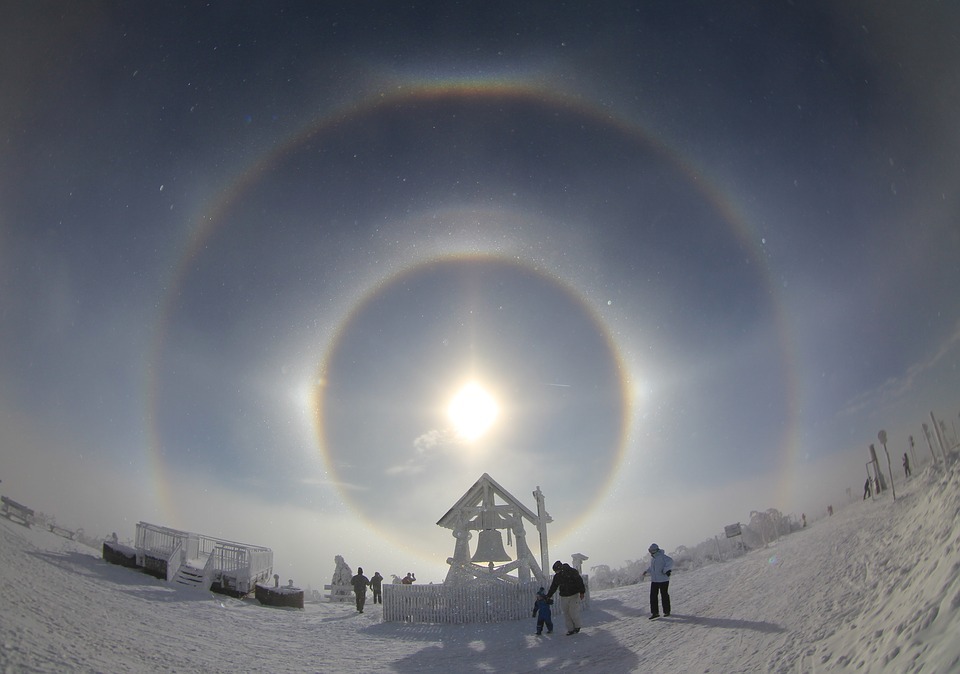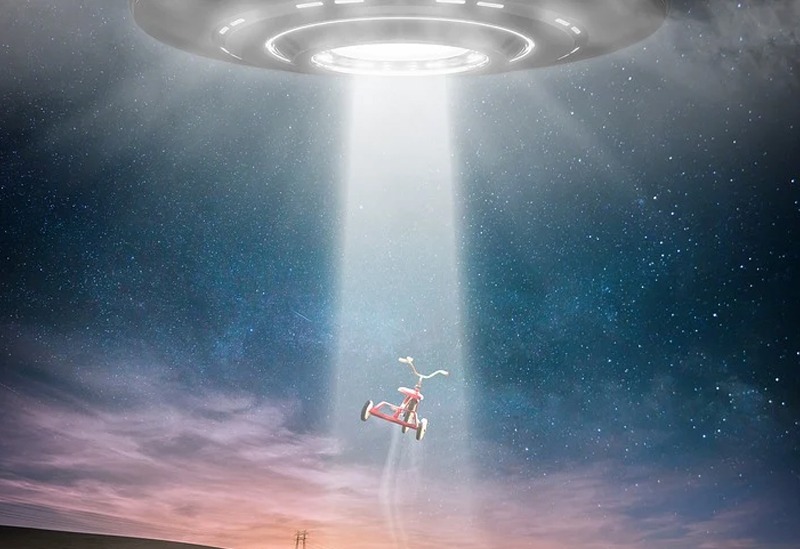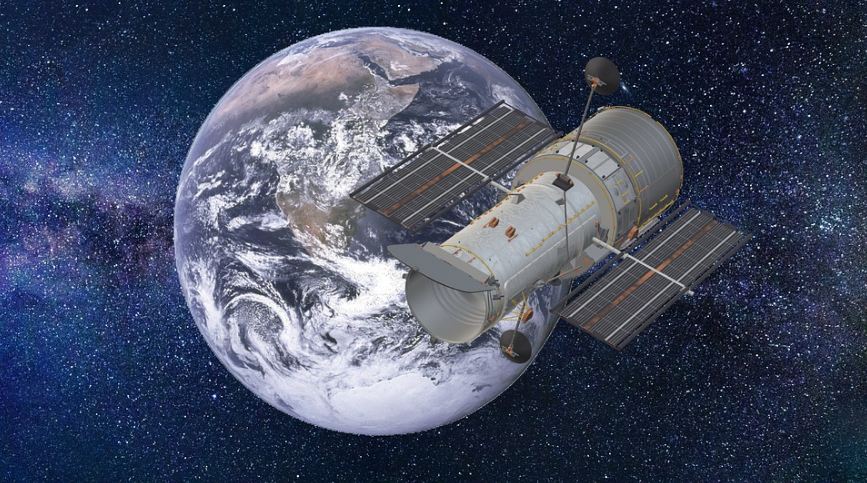The Habitable Zone: What It Means for Exoplanet Habitability
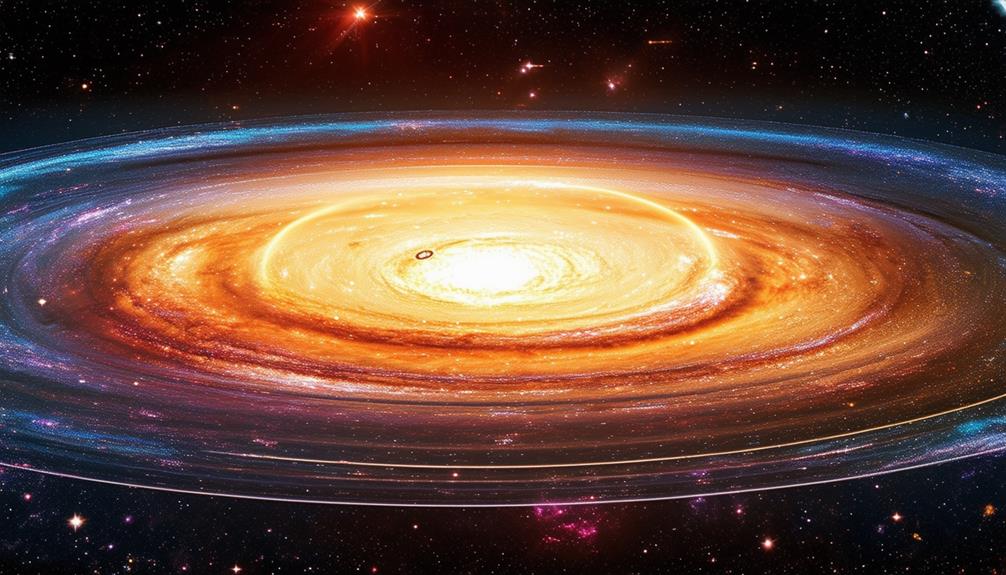
The concept of the habitable zone, often referred to as the Goldilocks zone, is crucial when considering the potential for life beyond Earth. This zone around a star is where conditions are just right for liquid water to exist, which is essential for life as we know it.
Understanding the habitable zone helps explain why certain exoplanets are considered potentially habitable. But what exactly makes a planet suitable for life, and how do different types of stars influence their habitable zones? These questions are fundamental as we explore the possibilities of life beyond our solar system.
Defining the Habitable Zone
Defining the Habitable Zone
The habitable zone, also known as the Goldilocks zone, is the region around a star where conditions are suitable for liquid water to exist on a planet's surface. This zone is critical because liquid water is essential for life as we know it. The location of the habitable zone varies depending on a star's luminosity. For example, the habitable zone around a dimmer star will be closer to the star compared to a brighter star.
In our solar system, the habitable zone extends approximately from 0.9 to 1.5 astronomical units. The inner edge of this zone is crucial because a planet too close might undergo a runaway greenhouse effect, rendering it too hot for liquid water. Conversely, a planet too far away could be too cold, causing water to freeze.
Understanding the habitable zone helps scientists identify where to search for potentially habitable exoplanets. By analyzing a star's luminosity, researchers can determine the optimal region where liquid water might exist, thereby increasing the likelihood of discovering life beyond Earth.
Importance of Liquid Water
When evaluating the habitability of exoplanets, the presence of liquid water is indispensable. It's essential for life as we know it and contributes significantly to maintaining stable environmental conditions. Without liquid water, the likelihood of discovering life on other planets diminishes considerably.
Essential for Life
Imagine a planet where liquid water flows freely—it's this essential component that makes life possible in the cosmos. Liquid water is indispensable for life, and its presence on exoplanets within the habitable zone significantly enhances their potential habitability.
When exploring the cosmos for signs of life, scientists prioritize finding planets where liquid water can exist. The habitable zone, often referred to as the 'Goldilocks zone,' is the region around a star where conditions are just right for liquid water to be stable.
Why is liquid water so crucial? It acts as a solvent for biochemical reactions, stabilizes climates, and facilitates nutrient transport. Without liquid water, the complex chemistry necessary for life as we know it can't occur. Therefore, when evaluating exoplanets for potential habitability, scientists focus on those within the habitable zone because it increases the likelihood of finding liquid water on their surfaces.
Stability of Conditions
In the quest for habitable exoplanets, stable conditions within the habitable zone are crucial as they ensure the presence of liquid water, essential for life as we know it. Liquid water is a fundamental requirement for life, making its presence a key factor in assessing exoplanet habitability. The stability of conditions within this zone ensures that temperatures remain conducive to sustaining liquid water. This stability is primarily influenced by the exoplanet's distance from its star, which determines whether it can maintain a climate that supports water in its liquid state.
An exoplanet located in a stable habitable zone has a higher likelihood of supporting life. Consistent conditions are essential, as significant fluctuations could either freeze or evaporate any existing liquid water. Evaluating the stability of these conditions is vital for assessing an exoplanet's habitability. It isn't sufficient to identify planets within the habitable zone; it's also necessary to confirm that their environments remain stable over extended periods. The stability of these conditions directly affects the potential for life, making it a critical factor in the ongoing search for habitable worlds beyond our solar system.
Star Types and Their Zones
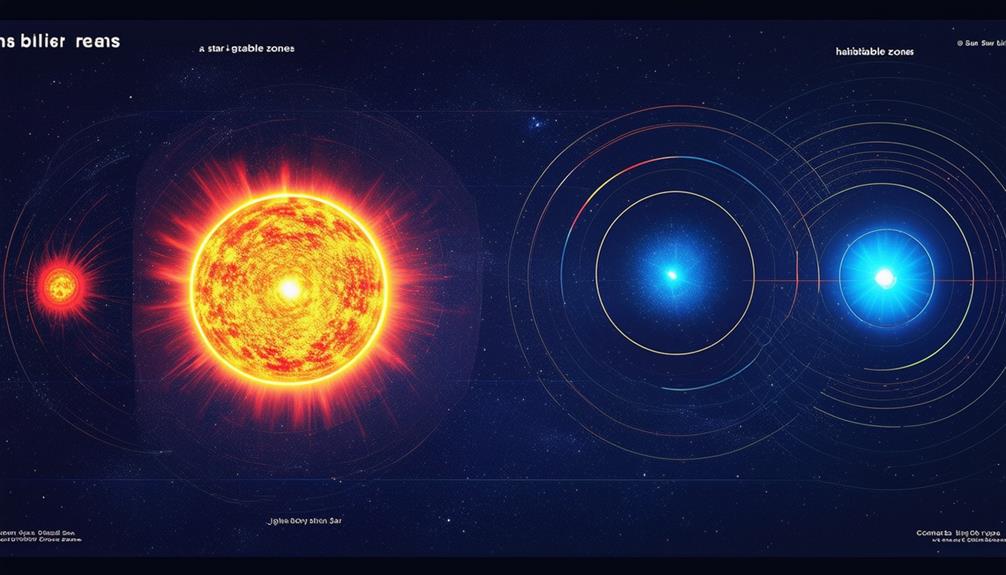
G-type stars, like our Sun, feature broad habitable zones where life could potentially thrive. K dwarf stars offer additional benefits due to their stability and longevity, making them excellent candidates for long-term habitability. In contrast, M dwarf stars present challenges due to their high radiation output, which can adversely affect the narrower habitable zones around them.
G Stars' Habitable Zones
G-type stars, like our Sun, have habitable zones where planets can sustain liquid water, making them prime candidates for hosting life. These regions, often called the 'Goldilocks zone,' are neither too hot nor too cold, allowing for the possibility of water in liquid form, which is essential for life as we know it.
When assessing the habitability of exoplanets, G-type stars provide a balanced environment. Their habitable zones are sufficiently wide to offer a stable climate over geological timescales, which is crucial for the development and evolution of life. The luminosity and temperature of G-type stars create conditions similar to those on Earth, making them excellent benchmarks for evaluating other potentially habitable worlds.
However, G-type stars have a shorter lifespan compared to some other types of stars, typically burning for about 10 billion years. While this is substantial, it isn't as long as the lifespans of K-type dwarfs. Despite this limitation, the habitable zones around G-type stars remain a key area of focus for astronomers searching for life beyond our solar system due to their favorable conditions for liquid water and overall habitability.
K Dwarfs' Longevity Advantage
K dwarfs, often referred to as 'Goldilocks stars,' offer a remarkable durability advantage, burning steadily for tens of billions of years. This extensive lifespan makes them exceptional candidates for hosting potentially habitable planets. Unlike their hotter G-type counterparts, K dwarfs provide a more steady energy output, which is vital for maintaining consistent conditions on orbiting planets.
Their habitable zones, though narrower compared to G stars, are still prime real estate for life. The steady energy output means that planets within this zone can enjoy long periods of climatic stability, which is necessary for complex life to evolve and thrive. With a K dwarf, you're looking at a star that won't flare up unpredictably, making it a safer bet for habitability over long durations.
Moreover, the longevity of K dwarfs dramatically increases the window during which life can potentially develop. Tens of billions of years is plenty of time for life to take hold, evolve, and achieve complexity. If you're searching for exoplanets with the highest chances of supporting life, K dwarfs are stars you shouldn't overlook. Their balance of longevity and steady energy output makes them ideal hosts for potentially habitable planets.
Red Dwarfs' Radiation Challenges
Red dwarfs, also known as M dwarfs, are cooler and fainter than our Sun, yet they're among the most abundant stars in the galaxy. Despite their potential to host habitable exoplanets, they present unique challenges for habitability due to their intense radiation.
Key points about red dwarfs and their habitable zones include:
- Intense Radiation: Red dwarfs emit strong X-ray and UV radiation, which can strip atmospheres from nearby planets, making it difficult for life to thrive.
- Narrow Habitable Zones: Because of their lower luminosity, red dwarfs have much narrower habitable zones. Planets must be closer to remain warm, which increases radiation exposure.
- Frequent Flares: Red dwarfs are known for their frequent and energetic flares, which periodically bombard planets with high-energy particles, complicating habitability.
- Atmospheric Erosion: The combined effect of intense radiation and frequent flares can erode planetary atmospheres over time, potentially eliminating any chance for sustained habitability.
Understanding these factors is crucial for evaluating the habitability of exoplanets orbiting red dwarfs.
Habitability Criteria
When evaluating exoplanet habitability, scientists consider several critical criteria, such as distance from a star, the presence of liquid water, and the composition of the atmosphere. These factors are essential for determining if a planet can support life. The habitable zone, often referred to as the 'Goldilocks zone,' is the region around a star where conditions are optimal for liquid water to exist. The absence of liquid water significantly reduces the potential for life.
| Habitability Criteria | Importance | Example |
|---|---|---|
| Distance from Star | Determines the planet's surface temperature | Earth is ideally positioned in the Sun's habitable zone |
| Presence of Liquid Water | Essential for life as we know it | Mars shows evidence of having had liquid water in the past |
| Atmosphere Composition | Regulates temperature and provides essential gases | Venus has a thick, inhospitable atmosphere |
The composition of a planet's atmosphere is crucial as it can shield the planet from harmful radiation, regulate surface temperatures, and supply essential gases like oxygen and carbon dioxide. Surface temperature must also be within a range that allows liquid water to exist. Understanding these factors enables scientists to assess the potential for life on other planets. By focusing on these criteria, we can better understand why some exoplanets are considered more promising candidates for habitability than others.
Current Exoplanet Discoveries
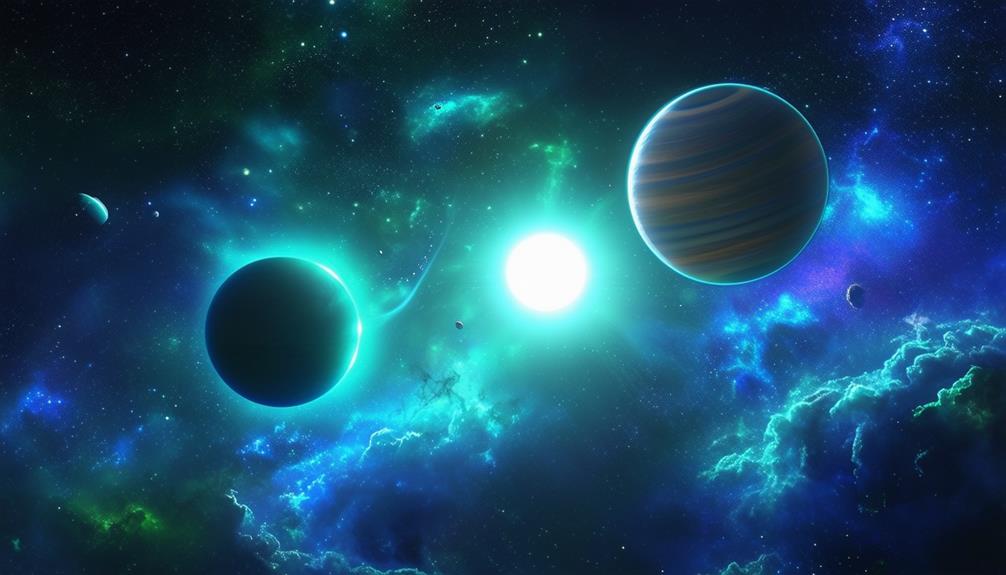
Scientists have made remarkable progress in discovering over 4,000 exoplanets, significantly expanding our understanding of potential habitable worlds beyond our solar system. These discoveries have revealed a diverse range of planets, many of which reside in the habitable zone of their parent stars, where conditions might allow for liquid water—a key ingredient for life.
Here are some exciting findings:
- Trappist-1 System: This fascinating system has seven Earth-sized planets orbiting a red dwarf star. Three of them are within the habitable zone, increasing the chances of finding liquid water.
- Proxima Centauri b: Located just 4.24 light-years away, this exoplanet orbits the closest star to our Sun, a red dwarf. It lies within the habitable zone, making it a prime candidate for habitability studies.
- Kepler-186f: This Earth-sized exoplanet orbits a red dwarf star and is located firmly within its habitable zone. Its discovery was a significant milestone in exoplanet research.
- LHS 1140 b: Another intriguing find, this rocky exoplanet orbits a red dwarf star and sits in the habitable zone, potentially having the right conditions for liquid water.
These findings underscore the importance of the habitable zone and the potential for life-sustaining environments around red dwarf stars.
Future Exploration Missions
Future exploration missions aim to revolutionize our understanding of exoplanet habitability and the search for extraterrestrial life. One of the most anticipated projects is the Habitable Worlds Observatory, slated for launch in the late 2030s or early 2040s. This mission will be second only to the James Webb Space Telescope in terms of power and capabilities.
The Habitable Worlds Observatory is specifically designed to study exoplanets within their habitable zones—the regions around stars where conditions may be just right for liquid water, a crucial ingredient for life as we know it. By concentrating on these zones, scientists hope to identify potentially habitable exoplanets and gain a deeper understanding of their atmospheric and surface conditions.
These exploration missions will employ cutting-edge technology to capture detailed data on exoplanets' compositions, climates, and other fundamental characteristics. The insights gathered could confirm or challenge our current theories about what makes a planet habitable.
As we delve deeper into the cosmos, these missions promise to uncover significant revelations, reshaping our knowledge of potentially habitable worlds and bringing us closer to answering the enduring question: Are we alone?
Potential for Life Beyond Earth
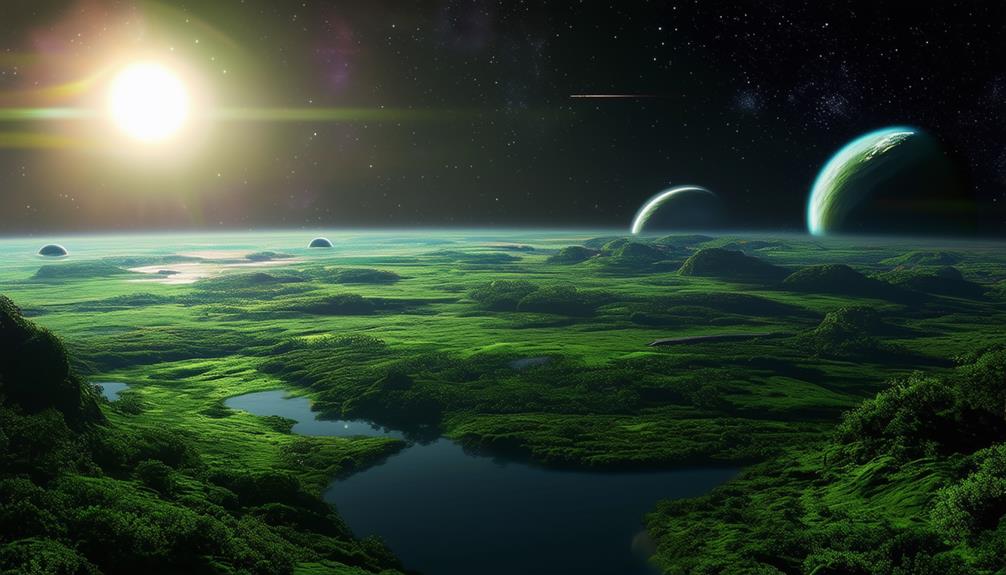
As we explore the vast universe with advanced missions like the Habitable Worlds Observatory, the possibility of life beyond Earth becomes increasingly captivating. Exoplanets in habitable zones, where conditions might support liquid water, are prime candidates in this search. Liquid water is crucial for life as we understand it, and discovering exoplanets within these habitable zones enhances their potential for life.
Red dwarf stars, for example, host planets that must orbit closer to the star to remain within the habitable zone, increasing the chances of liquid water. The Trappist-1 system is particularly fascinating due to its seven Earth-sized planets, several of which are located in the habitable zone, making them key targets for further study.
When considering the potential for life on exoplanets, several factors must be taken into account:
- Distance from the Star: Exoplanets need to be at the correct distance from their star to maintain liquid water.
- Star Type: Different stars have different habitable zones, impacting the potential for life.
- Planetary Atmosphere: A stable atmosphere can aid in preserving liquid water on the planet's surface.
- Geological Activity: This can assist in regulating the climate and sustaining life.
These factors collectively shape the potential for life beyond Earth.
Conclusion
Understanding the habitable zone is crucial for identifying potentially habitable exoplanets. Liquid water is a key requirement for life, and different star types have varying zones where liquid water can exist. By considering habitability criteria and current exoplanet findings, we can better evaluate the potential for life beyond Earth. With upcoming exploration missions, we're closer than ever to discovering other worlds that might support life. Keep exploring—the universe is vast and full of possibilities.


